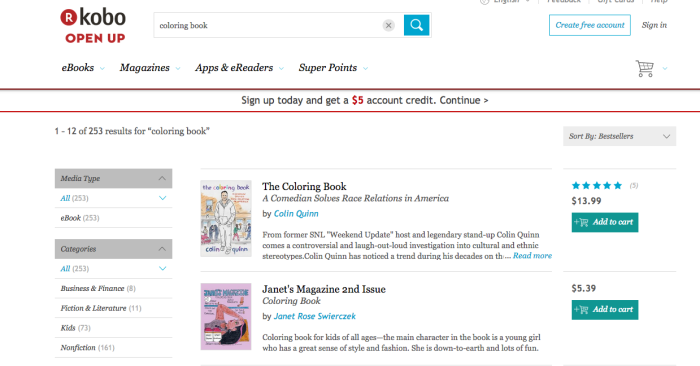
Sometimes curiosity can get the best of me, and then I just become more confused than I was before. While playing around with my Kobo Aura, I decided to search for “coloring books” just to see what there was. I was shocked to see that there were over two hundred results, all promising a fun colouring experience. Of course, having an E Ink device meant that actually being able to colour the pages of these books was next to impossible. Unless you wanted to take markers and colour on the screen of your device, which I don’t suggest you do.
So what was Kobo’s purpose in having colouring books available for purchase in their library? As it turns out, given the increasing popularity of colouring books, this may be an option Kobo is striving towards. At least, they are hoping to one day have coloured ink appear on their screens.
According to Rafi Letzter, we have yet to see colour appear on any E Ink devices due to the difficulty of making colour appear.
Unlike more common LCDs and LEDs that shine colored light at the viewer to create an image, e-paper screens reflect and absorb the ambient light in a room—just like a page in a book. Once e-paper displays an image, that image remains on the screen until an outside source changes it again…
This happens because e-paper displays rely on moving matter around instead of coloring bright lights.
However, it appears that Kobo, among other eReader companies, are working towards having their dreams realized. Andrew Liszewski detailed how E Ink Holdings has developed an E Paper that is capable of changing colours. The only downfall being that this technology has yet to be applied to any devices.
E Ink Holdings announced the availability of a new color-changing film known as Prism that’s based on the company’s electronic paper technology used in devices like Amazon’s Kindle … But the new material isn’t destined to finally bring a dash of color to your electronic books. Instead, it’s being positioned as a tool to let architects and interior designers dynamically change the color and mood of a space.
Unfortunately, there doesn’t seem to be much hope for colouring on our eReaders. Over the past few years, very little has taken place in terms of eReader innovation. Nathan of The eReader gave a very pessimistic outlook on the subject.
You have to wonder if it’s gotten to the point where E Ink eReader screens have reached their peak. Technology can only be advanced so far. Maybe the limitations of E Ink technology itself prevent any further improvements.
Color E Ink screens for eReaders came and went. E Ink tried them and failed miserably because of low contrast and poor color quality. Color E Ink has been at a complete standstill for three years.
Sorry folks, but we probably won’t be able to colour away on our eReaders anytime soon!

